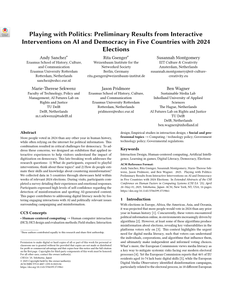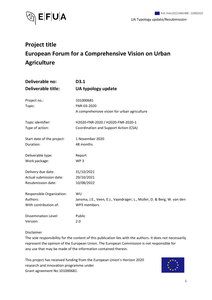The advent of information and communication technologies (ICTs) has had and is having a major impact on Indonesian cultural resource management, and on the safeguarding methods of its tangible and intangible cultural heritages. Despite varied levels and visible gaps between rural and urban regions in terms of technology usage, innovative initiatives have been created, which correspond to the needs and expectations of a technology-savvy public. As a starting point, a number of public institutions dealing with tangible cultural heritage (e.g. museums, palaces, temples, World Heritage Sites (WHS) do use innovative digital tools in order to communicate to various audiences, as well as to enrich visitors' experience, especially taking into consideration young generations. This paper will firstly examine the role of ICTs in intangible cultural heritage (ICH) (e.g. Batik, Wayang puppet theatre, etc.); secondly, the authors will explain how ICTs can help to communicate and promote the values, history, and significances of ICH products, both for locals and tourists, with the goal of raising awareness on cultural identity. However, the knowledge of ICH still requires contacts with its own communities and is vulnerable, as it can be exposed to excessive cultural commoditization through e-platforms. This study aims at giving an overview and some examples of digital interventions for cultural heritage communication implemented by various stakeholders in Indonesia. In addition, this paper analyses to what extent a participatory approach engaging local communities, academics, private sectors, NGOs and the government, can ensure higher levels of effectiveness and efficiency, hence supporting the conservation of UNESCO tangible/ICH in Indonesia. This paper aims at: (1) presenting the development of digital heritage platforms in Indonesia; (2) providing a grid of analysis of digital heritage knowledge platforms dedicated to UNESCO tangible and ICH in forms of websites and mobile apps.
MULTIFILE
Information and communications technologies (ICT) can be very important to provide access to urban cultural heritage collections. Urban archives contain a lot of (historical) information about people, places, events, objects, trade and artefacts. Its worthwhile to make this information accessible for a bigger public. The core challenge nowadays is to explore the role and meaning of ICT in disseminating this historical knowledge in public spaces. In this paper, we will research the theoretical background of the information value chain in archival science and of the use and context of new media technologies in public spaces. Our research method was a combination of desk research and a case study, in which new interactive media technologies were used to reconstruct historical images of Amsterdam in public spaces. The case study blended digital historical content with physical interactions to provide a user experience of urban history by using innovative storytelling techniques. The resulting prototype made it possible to disseminate historical information from Amsterdam urban archives.
MULTIFILE

Can you remember the last time the ground gave way beneath you? When you thought the ground was stable, but for some reason it wasn’t? Perhaps you encountered a pothole on the streets of Amsterdam, or you were renovating your house and broke through the floor. Perhaps there was a molehill in a park or garden. You probably had to hold on to something to steady yourself. Perhaps you even slipped or fell. While I sincerely hope that nobody here was hurt in the process, I would like you to keep that feeling in your mind when reading what follows. It is the central theme of the words that will follow. The ground beneath our feet today is not as stable as the streets of Amsterdam, your park around the corner or even a poorly renovated upstairs bedroom. This is because whatever devices we use and whatever pathways we choose, we all live in hybrid physical and digital social spaces (Kitchin and Dodge 2011). Digital social spaces can be social media platforms like Twitter or Facebook, but also chat apps like WhatsApp or Signal. Crucially, social spaces are increasingly hybrid, in which conversations take place across digital spaces (WhatsApp chat group) and physical spaces (meeting friends in a cafe) simultaneously. The ground beneath our feet is not made of concrete or stone or wood but of bits and bytes.
DOCUMENT

The objective of this paper is a reflective discussion on the validity of the construct Information Literacy in the perspective of changing information and communication technologies. The research question that will be answered is: what is the impact of technological developments on the relevance of the Information Literacy concept? Technological developments that will be discussed are: - content integration (federated search engines) - amateur publishing (user generated content) - use of social networks to find information - personalisation and push technology - loss of context / fragmentation of information. Research methods: desk research and critical analysis of the results that were found. The analysis of the influence of the discussed technologies on the Information Literacy concept is represented by arrow diagrams. Findings: The Information Literacy concept refers to a set of sub skills varying from retrieval skills to critical use of scholar information. Changing technologies reduce the significance of the more instrumental sub skills of the Information Literacy concept. On the other hand, higher order cognitive skills (for instance critical evaluation of resources and analysis of content) become more and more important for students and professionals who try to solve their information problems. The paper concludes with a description of the facets of the Information Literacy concept that need extra attention in the education of the knowledge workers of the future. [De hier gepubliceerde versie is het 'accepted paper' van het origineel dat is gepubliceerd op www.springerlink.com . De officiële publicatie kan worden gedownload op http://www.springerlink.com/content/n32j3um878720h40/abstract/]
DOCUMENT

More people voted in 2024 than any other year in human history, while often relying on the internet for political information. This combination resulted in critical challenges for democracy. To address these concerns, we designed an exhibition that applied interactive experiences to help visitors understand the impact of digitization on democracy. This late-breaking work addresses the research questions: 1) What do participants, exposed to playful interventions, think about these topics? and 2) How do people estimate their skills and knowledge about countering misinformation? We collected data in 5 countries through showcases held within weeks of relevant 2024 elections. During visits, participants completed a survey detailing their experiences and emotional responses. Participants expressed high levels of self-confidence regarding the detection of misinformation and spotting AI-generated content. This paper contributes to addressing digital literacy needs by fostering engaging interactions with AI and politically relevant issues surrounding campaigning and misinformation.
MULTIFILE

Urban Agriculture (UA) is rapidly evolving and changing and often entails more than the production of food. EFUA’s Working Package 3 therefore aims to identify the types and benefits of UA in the European context. This report is an update of the typology as described in the COST Action UAE. As existing typologies are often based on subjective observation rather than on empirical data and are also one-dimensional, this study is based on a systematic literature review about characteristics and existing typologies of UA, interviews with sixteen experts in the field representing eleven European countries and a questionnaire about specific UA initiatives amongst 112 respondents.
DOCUMENT

This article reflects on formal education for sustainable development (ESD), demonstrating how critical course on culturally diverse ways of relating to nature can contribute both to an appreciation of alternative ways of relating to nature and to a more nuanced understanding of one's own cultural and ideological positioning. This article will focus on the analysis of student reactions to the film Schooling the World, shown to students as part of this critical course. The film stimulated the discussion of the effects of Western-style education on indigenous communities. In their evaluation, the students have demonstrated their critical ability to look beyond their own neoliberal education and cosmopolitan culture. The course described in this article can serve as a blueprint for educational initiatives that combine both ethnographic insights and critical scholarship addressing environmental education and ESD. https://doi.org/10.1016/j.ijer.2013.10.002 https://www.linkedin.com/in/helenkopnina/
MULTIFILE

The report from Inholland University is dedicated to the impacts of data-driven practices on non-journalistic media production and creative industries. It explores trends, showcases advancements, and highlights opportunities and threats in this dynamic landscape. Examining various stakeholders' perspectives provides actionable insights for navigating challenges and leveraging opportunities. Through curated showcases and analyses, the report underscores the transformative potential of data-driven work while addressing concerns such as copyright issues and AI's role in replacing human artists. The findings culminate in a comprehensive overview that guides informed decision-making in the creative industry.
MULTIFILE

The Caribbean Netherlands are dealing with a situation where imported vegetables and fruits are mostly imported and hardly affordable. This leads to consuming unhealthy food and high obesities rates as a consequence. A lack of good agricultural practices with regard to water-smart and nature inclusive agriculture, as well as limited coping capacities to deal with hazards and climate change, results in very limited local production and interest. Initiatives that focused only on agrotechnological solutions for food resilient futures turned out to be ineffective due to a lack of local ownership, which jeopardizes sustainability. Moreover, the 'green' and 'blue' domains are not seen as attractive career perspectives among youth, hampering a bright future for those domains.
DOCUMENT

In this report the philosophy of the Conscious Destination is discussed. Also the bounderies of the hospitality domain and the core themes (as defined by CELTH) of Conscious Destinations will be described. These themes are: “Living environment”, “Human capital”, “Organising Capacity”, “Smartness” and “Leisure offer”.
DOCUMENT
